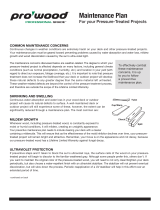
©2017 Universal Forest Products, Inc. Outdoor Essentials es una marca comercial registrada de Universal Forest Products, Inc. Todos los derechos reservados.
2801 E. Beltline NE, Grand Rapids, MI 49525 800.598.9663 9335_6/17
OutdoorEssentialProducts.com
Shadowbox
CÓMO INSTALAR UNA VERJA
LOS DIAGRAMAS E INSTRUCCIONES EN ESTE FOLLETO TIENEN SOLO FINES ILUSTRATIVOS Y NO PRETENDEN REEMPLAZAR A UN PROFESIONAL CON LICENCIA. CUALQUIER CONSTRUCCIÓN
O USO DE ESTE PRODUCTO DEBE ESTAR EN CONFORMIDAD CON TODOS LOS CÓDIGOS LOCALES DE ZONIFICACIÓN Y/O CONSTRUCCIÓN. EL CONSUMIDOR ASUME TODOS LOS RIESGOS Y
RESPONSABILIDADES ASOCIADOS A LA CONSTRUCCIÓN O EL USO DE ESTE PRODUCTO. EL CLIENTE O EL CONTRATISTA DEBE TOMAR TODAS LAS MEDIDAS NECESARIAS PARA GARANTIZAR
LA SEGURIDAD DE TODOS LOS INVOLUCRADOS EN EL PROYECTO -INCLUYENDO PERO NO LIMITADO A- EL USO EL EQUIPO DE SEGURIDAD APROPIADO. SALVO LO EXPRESADO EN LA GARANTÍA
LIMITADA POR ESCRITO, EL GARANTE NO OFRECE NINGUNA OTRA GARANTÍA, EXPLÍCITA O IMPLÍCITA, Y NO SERÁ RESPONSABLE POR NINGÚN DAÑO, INCLUSO LOS INDIRECTOS.
CUIDADO Y MANTENIMIENTO
PROBLEMAS COMUNES DE MANTENIMIENTO
Los continuos cambios de las condiciones climáticas son muy
perjudiciales para su cerca. Su plan de mantenimiento debe estar
orientado a combatir los problemas causados por la absorción y
pérdida de agua, el crecimiento de moho y la decoloración de la
madera por los rayos ultravioleta del sol. Todos los problemas de
mantenimiento que se discuten a continuación están relacionados
con las condiciones climáticas. El grado hasta el cual su cerca se
vea afectado por ellos depende de muchos factores. Estos factores
incluyen las condiciones climáticas (como las precipitaciones
normales, la humedad, etc.) y la ubicación de la cerca en su patio
(con respecto a la exposición directa al sol, la cobertura del
follaje, etc.). Si su cerca está hecha con madera tratada a presión,
es importante señalar que el tratamiento a presión no aumenta
las probabilidades de que su cerca desarrolle estos defectos
naturales en un grado superior al que lo haría el mismo material
sin tratamiento. Estos defectos relacionados con el clima están
fuera del control del proceso de tratamiento a presión.
CARACTERÍSTICAS NATURALES DE LA MADERA
No podemos controlar la existencia de las características
naturales de la madera, que pueden incluir grano resaltado,
fisuras, deformación, encogimiento, hinchazón o torsión. La
constante absorción y pérdida de agua en la madera utilizada
para su cerca hará que se emerjan sus defectos naturales.
Incluso una cerca con buen mantenimiento experimentará
algunos de estos defectos naturales. Sin embargo, su extensión
puede reducirse significativamente con un plan de mantenimiento.
Depende de usted seguir un plan de mantenimiento preventivo
que le permita combatir estos problemas de forma eficaz.
Su plan de mantenimiento inicial debe estar determinado por
la absorción y pérdida de agua, el crecimiento de moho y la
decoloración por rayos UV.
• Mantenimiento durante el primer año: Vuelva a aplicar
limpiador/abrillantador como se describió en el mantenimiento
inicial y según lo requiera el acabado de su elección (pintura,
barniz o sellador impermeable).
• Mantenimiento preventivo periódico futuro: Según la
ubicación de su cerca con respecto a la exposición solar,
la cobertura del follaje, etc., puede que solo sea necesario
limpiar/pulir y pintar de nuevo la madera cada dos años.
Podría necesitar una lavadora a presión para limpiar
adecuadamente su cerca.
CÓMO INSTALAR LOS PORTONES
CÓMO TERMINAR LA VERJA
• Determine la dirección en la que abrirá el portón (si abre para la
izquierda o la derecha).
• Monte los herrajes del gozne al marco del portón a la altura
apropiada, una vez taladrado los agujeros de los tornillos con
anterioridad.
• Monte el portón al poste del portón, una vez taladrado los
agujeros de los tornillos con anterioridad.
• Verifique que haya espacio para abrir el portón completamente
• Monte los pasadores, una vez taladrado los agujeros de los
tornillos con anterioridad.
Se recomienda aplicar un acabado protector para prolongar la
vida de la verja. El tipo de acabado se determinará por la apari-
encia deseada así como también por las especies de madera que
se utilicen. Hay tres opciones en tratamientos de acabado: tinte,
pintura y sellador impermeable. Limpie la verja con un limpiador o
aclarador que contenga un fungicida antes de aplicar el acabado.
• El tinte provee una capa de acabado duradera y a la vez
mantiene la apariencia natural de la madera. Se recomienda un
tinte semitransparente para verjas nuevas; le da una apariencia
uniforme y un toque de color, y a la vez permite mostrar las vetas.
• La pintura le añade color y además protege y sella la verja. El
color se puede coordinar fácilmente con su hogar. Limpie, seque
y aplique primero un primer a base de aceite antes de pintar la
verja. Se recomienda que utilice una pintura de látex de exterior
duradera.
• El sellador impermeable es lo mejor para las maderas que
no son naturalmente resistentes a la descomposición y a la
exposición a la intemperie. El sellador ayuda a prevenir que la
lluvia y la humedad empapen la madera. Añada un estabilizador
de rayos UV para hacer más lento el proceso de decoloración.

















